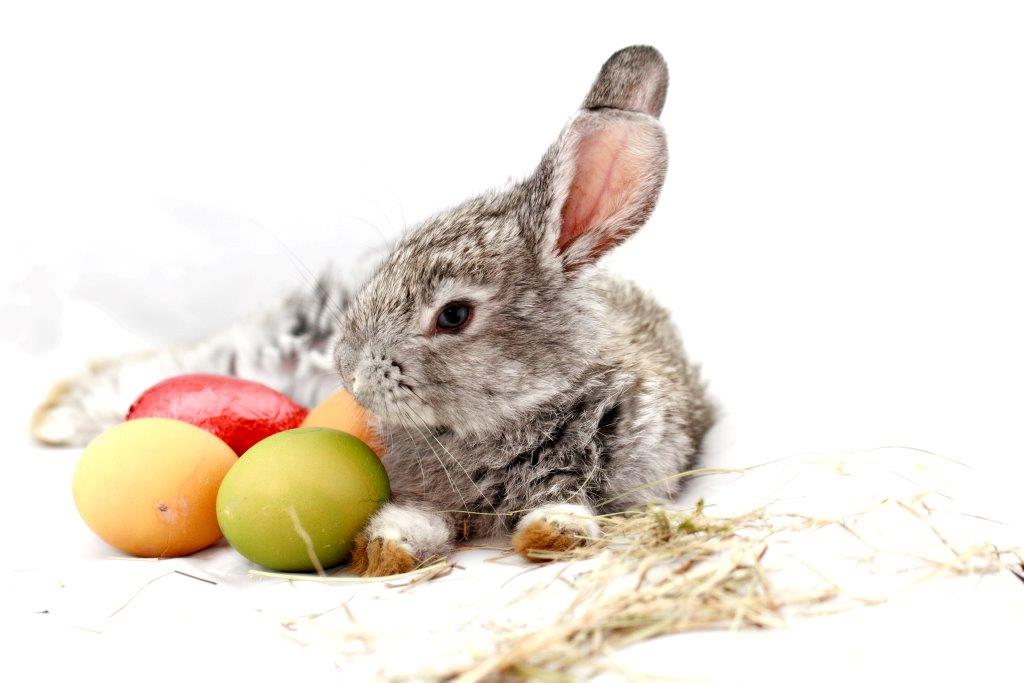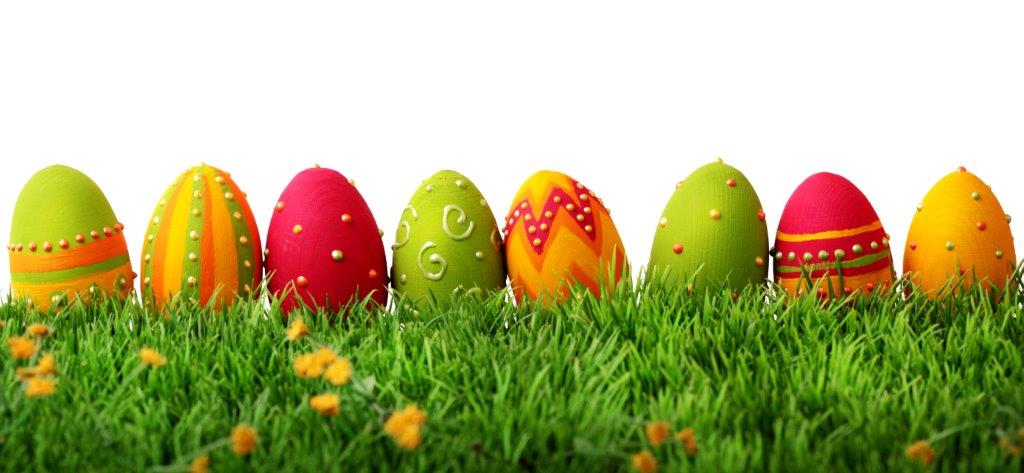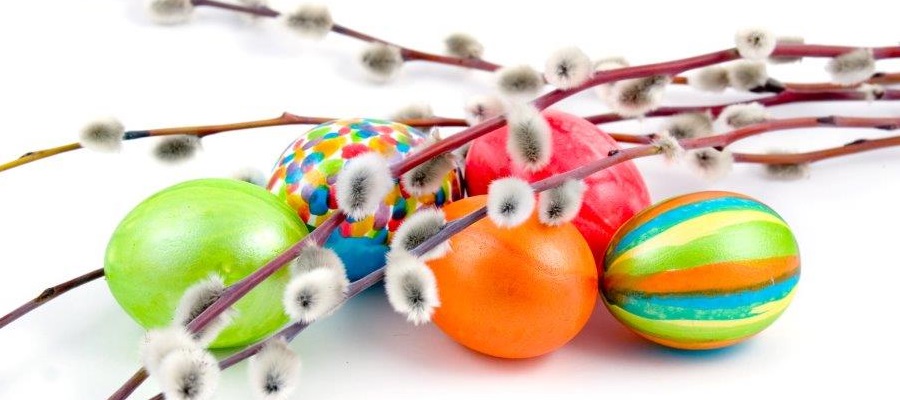Palm branches, ashes, the Easter Bunny, Easter bonnets1, painted eggs, baby chickens and church services2 at sunrise are symbols and images of US Easter celebrations. These traditions, which vary greatly according to religion and geographical location in the States, are quite different from those in your country.
Easter, like Christmas, is one of the holidays which has two distinctly different meanings to people. For Christians, Easter is by far the most religious or sacred3 holiday of the year. The Easter season actually begins forty days before Easter Sunday. It is a period of time known as Lent4. It is a period of time, similar to Advent, in which believers prepare for Easter. Many believers use this time to remember the sacrifice5 made by Jesus Christ. In this period they are willing to give up something significant in their lives. It is common to hear someone ask another person, “So what did you give up for Lent?” People may give up eating meat or chocolate or drinking alcohol. They may also fast6, which is to go without food for a certain amount of time.
Lent begins on Ash Wednesday7. Many churches hold services at which a bit of ashes are put on the worshippers’ forehead8 as a symbol of humility and the inevitability of death9.
There are four important days during Holy Week – the last week of Lent. This week recalls the events leading to Jesus Christ’s death and resurrection10.
PALM SUNDAY11: Many church services across the US spend this Sunday remembering and celebrating Jesus’ triumphal entry into Jerusalem. He was greeted by crowds of people waving branches of palm trees and celebrating his arrival. In less than one week these same people condemned12 him to death. Today many churches incorporate palm branches into this service. They may be carried by a procession of singing children entering the church or are used as decorations in the church.
Jerusalem. He was greeted by crowds of people waving branches of palm trees and celebrating his arrival. In less than one week these same people condemned12 him to death. Today many churches incorporate palm branches into this service. They may be carried by a procession of singing children entering the church or are used as decorations in the church.
MAUNDY THURSDAY13: Many churches hold a special service on this day, the day before Jesus’ crucifixion14, to remember the Last Supper – the last meal of Jesus when he washed his disciples’ feet, as a display of his humility. On this day, all decorations are removed from the church altar.
GOOD FRIDAY15 is the most solemn16 day of Holy Week. Services are held to commemorate the crucifixion of Jesus Christ by the leaders of Jerusalem. The mood of the service and songs reflect the sadness believers feel for the death of Jesus Christ. Many Christians eat little or no food on this day.
EASTER SUNDAY is a sharp contrast to Good Friday. Easter Sunday morning is a joyous celebration of Jesus’ resurrection. Services are full of happy, uplifting songs, and churches are decorated with Easter lilies. Many churches hold sunrise services outdoors as they sing hymns of celebration while watching the sun rise over the horizon on a glorious day.
SECULAR17 CELEBRATIONS
Most Americans also participate in the secular side of Easter. Eggs, rabbits and baby chickens are three symbols of new life or fertility as spring approaches. The Easter version of Santa Claus is the Easter Bunny. The Easter Bunny, usually dressed up in a large colourful rabbit suit (sorry, he is not real either), brings gifts of coloured eggs, candy, and chocolate eggs and rabbits to children. Many parents tell their children that the Easter Bunny lays18 Easter Eggs. He hides these eggs in the grass, in bushes and trees. It is then the children’s task to find as many eggs as possible. The kids race across the lawn bumping19 into each other and often fight over who gets to an egg first. Watchful parents make sure that each child finds at least one Easter egg. The Easter Bunny is usually present at these egg hunts. For over a hundred years, children have been invited to the White House Lawn in Washington, D.C., for a huge Easter Egg Hunt.
I remember quite well how the Easter Bunny (or perhaps my mother) would hide candy eggs and chocolate bunnies all over the house for our Easter egg hunt. My brother, two sisters and I had to look for them on Easter morning. We tried to see who could find the most. Sometimes we wouldn’t find all of them, and months later we would occasionally find an egg hidden somewhere behind a book.
For many people, it is also important to wear new clothes to church on Easter. The new clothes are a symbol of new life. It is also popular for women and girls to wear a new Easter bonnet on Easter.
Ham is the most traditional Easter dinner item (much the same as turkey for Thanksgiving) when families gather for an Easter dinner.
Another popular Easter custom is an Easter walk or a parade. In New York City, thousands of people in their new clothes participate in a grand Easter Parade down Fifth Avenue following Easter services.
Easter is truly the symbolic beginning of spring. As with the resurrection of Jesus Christ, new life returns to earth after the long winter as flowers and leaves begin to appear. As you can see, there is a great variety of traditions, beliefs, symbols and celebrations connected with Easter.
ACTIVITY:
– Explain the meaning of the words which are printed in bold.
– Which American Easter tradition was unknown to you?
– Do you also get any presents from the Easter Bunny?
– Jake has not mentioned our customs and traditions on Easter Monday. Explain to a foreigner what our “šibačka” is.
Jake Slegers
VOCABULARY: 1 ženský (detský) klobúk – ženský (dětský) klobouk; 2 bohoslužby; 3 posvätný – posvátný; 4 pôst (pred Veľkou nocou) – půst (před Velikonocemi); 5 obetovanie – obětování; 6 držať pôst – držet půst; 7 popolcová streda – popeleční středa; 8 čelo veriacich – čelo věřících; 9 symbol pokory a nevyhnutnosti smrti – symbol pokory a nevyhnutelnosti smrti; 10 vzkriesenie – vzkříšení; 11 Kvetná nedeľa – Květná neděle; 12 odsúdiť – odsoudit; 13 Zelený štvrtok – Zelený čtvrtek; 14 ukrižovanie – ukřižování; 15 Veľký piatok – Velký pátek; 16 pochmúrny, ponurý; 17 svetský – světský; 18 znášať – snášet; 19 vrážať – vrážet

